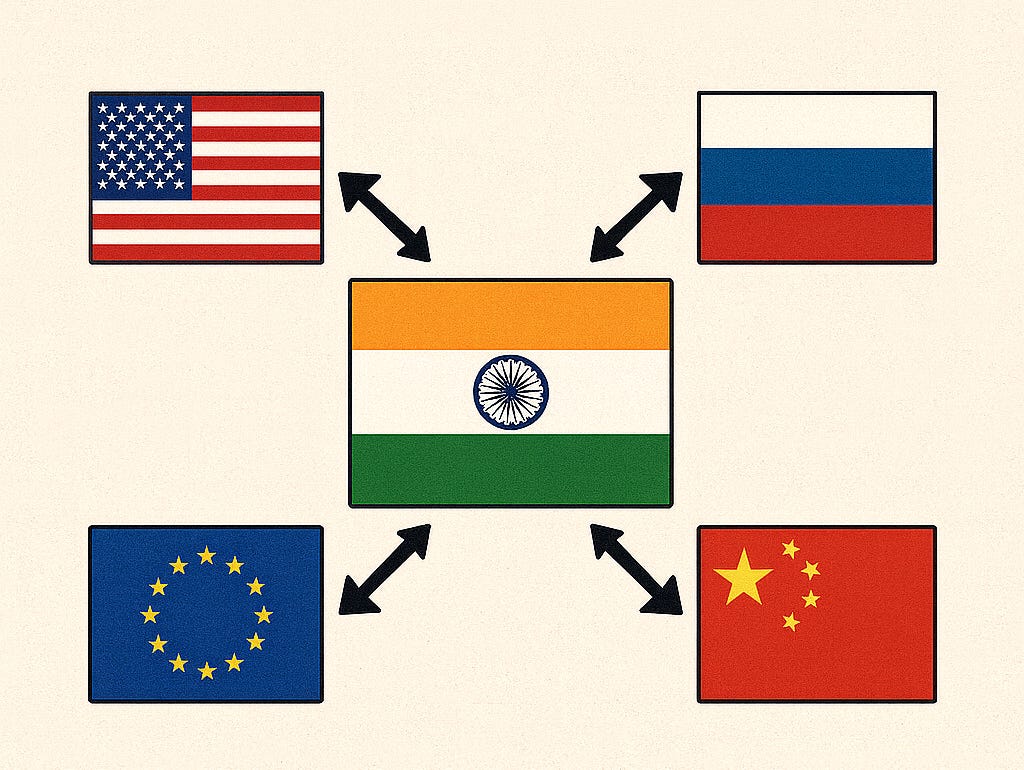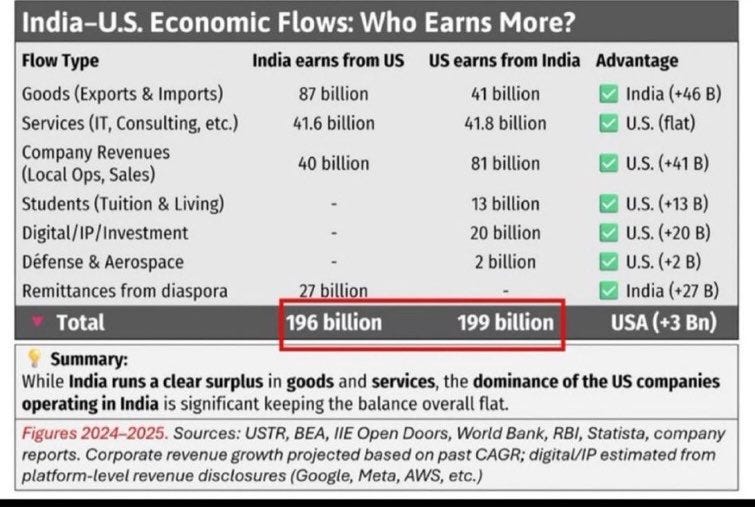India today occupies a unique place in the global order, neither bound by the rigidities of the Cold War nor willing to be absorbed into the orbit of any major power. With its demographic scale, technological ambitions, and growing economic clout, it has emerged as a central player in shaping the 21st century. What distinguishes India from other rising powers is its foreign policy doctrine of multi-alignment, built firmly on the foundation of strategic autonomy. This doctrine is not fence-sitting or indecision but a deliberate choice rooted in history and geography. It is a way of engaging multiple partners without surrendering independence, maximizing options in a world fractured by great power rivalries. The doctrine was on full display at the recent SCO Summit in Tianjin, where Prime Minister Narendra Modi executed a masterclass in balancing. He attended the summit and reinforced ties with China and Russia, underscoring India’s willingness to work within Eurasian frameworks. Yet he deliberately skipped Beijing’s military parade, avoiding the optics of standing alongside Kim Jong Un and preventing discomfort in Tokyo, a vital partner for India. In this way, Modi hedged India’s bets while signalling to Western capitals that New Delhi’s doors remain open but that it will not be boxed into an anti-China alliance, nor will it embrace the anti-Americanism of a Sino-centric axis. This subtle but firm message encapsulates India’s approach to global politics: independent, pragmatic, and multipolar in outlook.
Behind the geopolitical manoeuvring lies an equally revealing economic story. For years, successive U.S. administrations have framed India as a beneficiary of American openness, highlighting the large Indian goods surplus in bilateral trade. Indeed, India exports far more merchandise to the United States than it imports, fueling the perception that Washington is on the losing end of the relationship. Yet when the entire balance of flows is considered, a more complex picture emerges, one in which the United States actually runs an overall surplus. According to 2024–25 data, India earns about $196 billion from the United States while the United States earns roughly $199 billion from India. This $3 billion surplus in Washington’s favour is not only real but also strategically significant, for it reveals where the structural advantages lie. India’s goods trade surplus amounts to $46 billion, but the United States makes up for this through dominance in services, digital/IP, education, defence, and corporate revenues. American companies earn $81 billion in India, double what Indian firms make in the U.S., demonstrating the extent of U.S. corporate penetration of Indian markets.
Technology giants like Google, Meta, Amazon, and AWS extract immense value from India’s digital economy, while U.S. universities rake in $13 billion annually from Indian students. The United States also secures $20 billion through its dominance in intellectual property and digital services, and $2 billion through defence and aerospace sales. India’s counterbalance comes largely from remittances, earning $27 billion annually from its diaspora in America, a powerful but limited offset. Taken together, these figures expose the flaw in Washington’s narrative. Far from being a drain on the U.S., India is already a profitable partner for America. This reality should temper the temptation in Washington to wield tariffs and trade threats as bargaining tools, for they risk undermining a relationship from which the United States already derives structural advantage.
Understanding India requires more than just economic data; it requires sensitivity to its political DNA. For decades, seasoned strategists have articulated three unwritten rules for handling India. First, never adopt a bullying or threatening posture, for India’s colonial memory ensures that ultimatums are met with resistance, not compliance. Second, never claim to resolve India’s disputes with Pakistan from the outside, for sovereignty over Kashmir is non-negotiable and external mediation is unacceptable. Third, never behave as though the Pakistani army is your privileged partner, for New Delhi regards Rawalpindi as the chief obstacle to peace in South Asia. These principles are not optional guidelines but red lines grounded in historical experience. They explain why phases of successful Indo-U.S. engagement have coincided with respect for India’s autonomy and sovereignty, as seen in the Clinton, Bush, and Obama years, when the relationship deepened steadily through trust and recognition of India’s unique position.
The Trump administration, however, chose to ignore these lessons, misreading India’s foreign policy at a critical juncture. In a short span, it managed to break all three of the cardinal rules. By threatening tariffs and cornering New Delhi on trade, it adopted the very bullying posture India rejects. By floating the idea of U.S. mediation in India & Pakistan, Trump struck at the heart of India’s sovereignty. By cozying up to Pakistan’s military establishment his administration signalled that Washington still saw Rawalpindi as an indispensable partner, undermining Indian confidence. In doing so, Trump undid nearly 25 years of bridge-building. The Clinton years had paved the way for engagement after the 1998 nuclear tests. Bush had overseen the 2008 Civil Nuclear Deal, a landmark in bilateral ties. Obama had elevated India to a strategic partner in the Indo-Pacific. Trump, by contrast, turned the clock back, undoing trust and leaving scars that will take time to heal. A tariff deal may still be reached in the coming months, but the larger damage is one of credibility. For Indian policymakers, the Trump years confirmed that Washington could swing unpredictably, disregarding India’s red lines when convenient. This experience has reinforced New Delhi’s determination to never again rely too heavily on one partner, no matter how important.
Compounding this misreading of India was Trump’s own backward-looking economic vision. His recent remark that the United States was at its “richest ever” in the late 19th century under a tariff-based system reflects a deeper ideological pivot in American economic thought. By invoking the pre 1913 era before the federal income tax and before the U.S. embraced large-scale globalization Trump situates tariffs and fossil fuels at the core of America’s future. Yet this pivot is taking place while the rest of the world is racing ahead into the 21st century, retooling their economies for renewable energy, electric mobility, and advanced technologies.
The U.S., by contrast, risks ceding leadership in the very sectors that will define global competitiveness. From 1850 to 1913, the U.S. economy did indeed rely heavily on tariffs to fund federal revenues, with customs duties making up over 90 percent of government income. Industrial growth surged during this period, but that was in the context of an emerging manufacturing economy, vast natural resource exploitation, and a largely protected domestic market. The world has changed. Today’s prosperity rests on technological dominance, global supply chains, and innovation ecosystems areas where fossil-fuel dependency and tariff walls may prove more of a drag than a driver.
China exemplifies this contrast. According to the International Energy Agency, by 2030 China is projected to generate as much solar energy as the entire United States’ current total power generation capacity across coal, gas, nuclear, and renewables combined. It already controls 80 percent of global solar module production, 60 percent of wind turbine manufacturing, and nearly 75 percent of battery production capacity. Beijing has framed this dominance not only as an energy transition but as a strategic tool for economic and geopolitical leverage in the 21st century.
India, too, has embraced the new energy paradigm. It has committed to reaching 500 gigawatts of renewable energy capacity by 2030 and has already crossed 180 gigawatts in solar, wind, and hydro combined. India is also building one of the world’s largest electric vehicle adoption programs, with EV sales expected to reach 30 percent of total new vehicle sales by 2030. Tesla’s entry, coupled with domestic champions like Tata Motors and Mahindra, is accelerating this shift. Moreover, India is positioning itself as a major hub for green hydrogen, a technology critical for decarbonizing industries like steel and cement.
Meanwhile, the United States under Trump risks doubling down on fossil fuels and protectionist tariffs. While oil and gas still contribute nearly 8 percent of U.S. GDP and support millions of jobs, global trends point towards peak fossil fuel demand in the 2030s. The European Union has already pledged carbon neutrality by 2050, China aims for 2060, and India for 2070. The U.S., by emphasizing coal, shale oil, and tariff-era economics, could find itself both economically isolated and technologically outpaced. Washington is no more center of gravity of global economy and rising giants in Asia like China & India are now beating hearts of global growth. No power blocs in the world can ignore 3-4 billion people in Asia. The fourth turning is upon the world and Americans are yet to realize the gravity of the shift underway.
The irony is striking i.e. protectionism in the 19th century helped America catch up with Britain’s industrial supremacy, but in the 21st century, protectionism risks shielding inefficiencies rather than fostering innovation. Tariffs may protect certain industries, but they also raise costs for consumers and disrupt supply chains. More critically, they do nothing to prepare the U.S. for the global race in artificial intelligence, green energy, and advanced manufacturing areas where China, India, and the EU are already competing fiercely. Energy transitions have always defined global power shifts, from coal to oil to nuclear. In the 21st century, the decisive shift is towards renewables, EVs, and smart grids. If America pivots back to the 19th century, it risks losing the future to those racing ahead.
For India, this American pivot reinforces the logic of multi-alignment. By hedging across relationships, India ensures that it is never trapped by the miscalculations of any single partner. Prime Minister Modi’s actions at the SCO, the trade balance data, and the Trump administration’s economic philosophy all point to the same conclusion: India cannot rely on others to chart its path. It must navigate a turbulent world independently, extracting benefits from all sides while preserving its sovereignty. Washington may still hope for deeper strategic convergence, but it must learn to engage India as an equal, respecting its autonomy and recognizing its long-term vision. The world is shifting irreversibly towards multipolarity, and India intends not to be a bystander but an independent pole shaping the order.
India’s multi-alignment doctrine, anchored in strategic autonomy, is its contribution to the global system at a time of turbulence. It represents continuity with the Multi-Aligned Movement, adapted to a world where power is more distributed. It represents an assertion of sovereignty in trade, technology, and security. And it represents a challenge to all powers that seek to box India into their rivalries. Far from fence-sitting, it is a bold strategy of independence, one that ensures India’s rise on its own terms. The Trump years showed the costs of misreading this doctrine, undoing decades of progress. The danger of Trump’s 19th-century economic nostalgia only reinforces the need for India to think beyond others’ ideologies and chart its own course. The lesson for the world is simple: to work with India, one must respect its autonomy. To misjudge it is to risk losing it. It is quiet ironical that the Trump Administration while trying to target Indian economy has only helped cement its diplomatic & strategic profile as a rising pole in Multi-Polar global order. New Delhi is in now effectively setting benchmarks how Washington must be dealt while safeguarding its national interests and protecting its strategic autonomy.
As Washington balks at Delhi’s Defiance the world is now looking towards it as a rising power setting the trend & benchmarks for others to follow suit. India is now talk of the town across global capitals for standing up to American bullying and its unjust demands. The Sun is truly rising in East once again as American Empire descends ever so gradually in its Twilight.





Great Post! One thing is for sure when the time comes to trade with them, use insulting language because they will only understood that way, not in a good language for sure.